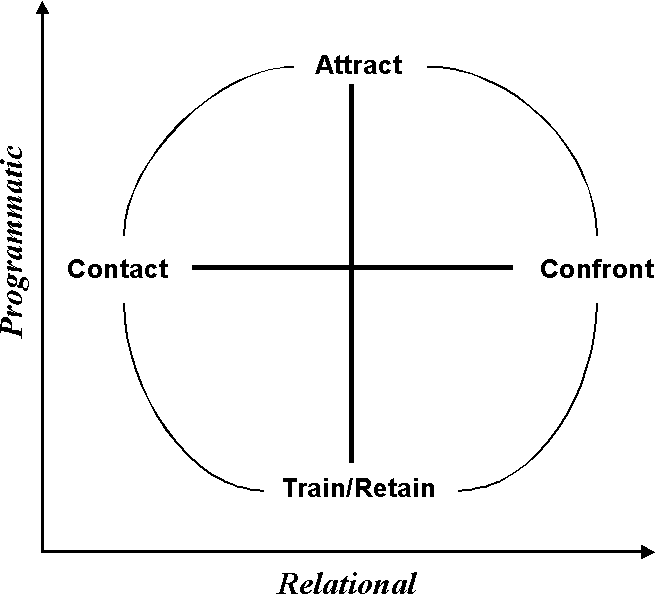

On the Relational Axis there are two functions - contact and confront. Youth ministry begins when a youth worker finds a comfortable way of entering the world of a young person - making contact. On the other side of the relational axis is confrontation with the Christian gospel. The young person needs to hear about their condition and Godís provision of salvation. The closer the relationship between adult and youth, the closer the distance between contact and confrontation. Youth should only be confronted at the highest point of relationship. Also, the more people involved in the delivery system, the more structure is needed.
On the Programmatic Axis there are two functions - attract and retain/train. Programmes are delivery systems in which people experience the gospel or grow in Christ. Attracting youth to an event in which they are presented with the gospel is key. Retaining/training youth is a long-term process whereby spiritual commitments are strengthened and leadership qualities are developed. More programming is needed to attract youth to an event where they are converted, than is needed to train them for ministry because it is the result of a lifestyle of discipleship.
The whole process is as follows: a non-believing youth is contacted by a peer/adult; they are attend to an event in which the gospel confronts them and where they are assimilated into a formal nurturing process. The end product is youth who are actively involved in contacting spiritually sensitive peers in an attempt to bring them to Christ.
Adults involved in discipling youth have two roles in ministry among youth: prophet and shepherd. In the next diagram these the roles are placed on two axes. These roles relate to four components in the life of youth: curiosity; need; commitment and truth.
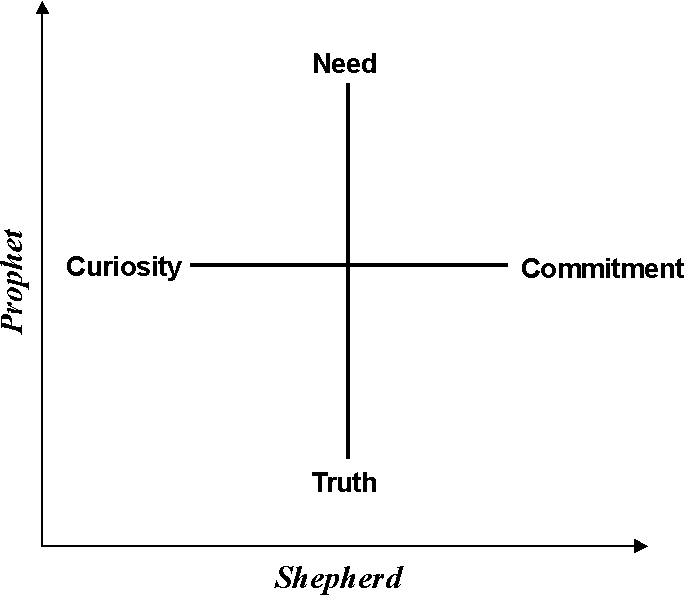
The Shepherd Axis responds to two motivations of youth - curiosity and commitment. The role of the shepherd is to move youth from curiosity about spiritual matters to commitment to Jesus Christ. This relates to the relationship axis of the delivery system. The shepherd must be sensitive to the pace than an individual moves at and respond to their developmental changes.
The Prophet Axis focuses on two aspects of the human/eternal equation - needs and truth. As a prophet, the youth worker must move youth from their felt needs (ie. developmental tasks) to a place where they understand and accept Biblical truth.
The delivery system in youth ministry is superimposed on the adult roles in youth ministry to show the process of youth discipleship.
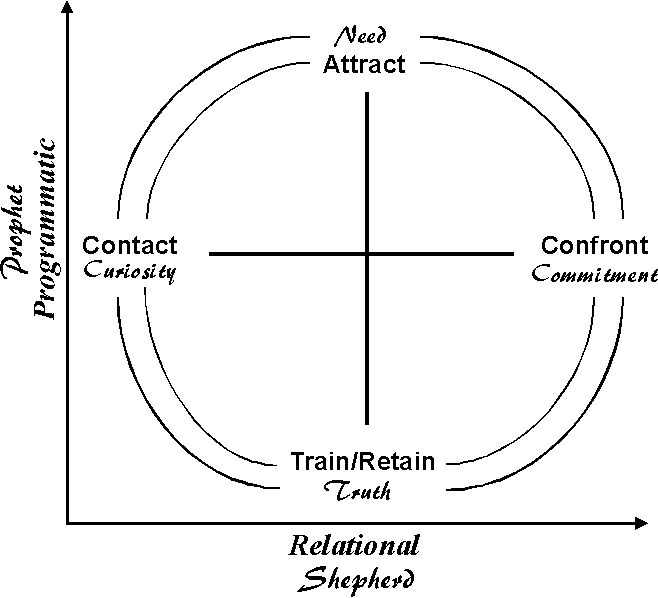
From the model, the process of discipleship involves four stages: bringing; converting; strengthening and sending.
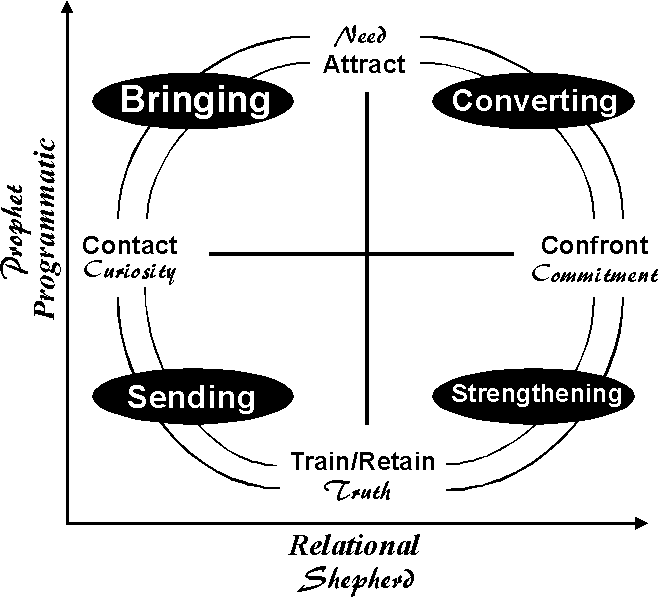
1. The Bringing Stage
The youth worker makes contact with non-Christian youth through raising their curiosity and touch felt-needs and attracts them into a youth group; club or drop-in center.
2. The Converting Stage
The young person is confronted with the gospel of Christ and challenged to commit their life to Christ.
3. The Strengthening Stage
The new convert is retained in the local church youth ministry where they learn truth about Christianity.
4. The Sending Stage
The growing believer is trained to be part of the churchís mission and they are sent out to do ministry.
Mark Senter says that existing youth ministries are not effective in all quadrants and that each type of ministry is strong in one or two parts of the process (his application is directed towards para-church ministry more than local church ministry). For example some are good at bring/converting like Young Life and Youth For Christ; some are good at converting/strengthening like Student Impact at Willow Creek; some are good at strengthening like Sunday School and AWANA; and some are good at strengthening/Sending like Sonlife Missions and YWAM.
In terms of a local church context it is my conviction that we do not have the luxury of choosing to work in one or two quadrants. The whole process of discipleship is essential in a local church context. The youth ministry should seek to move young people from bringing right around to sending, with various events and ministries aimed at each level in between.
By way of application into your youth group or youth ministry context, use the following chart to indicate ministries that you have in each of the four quadrants.
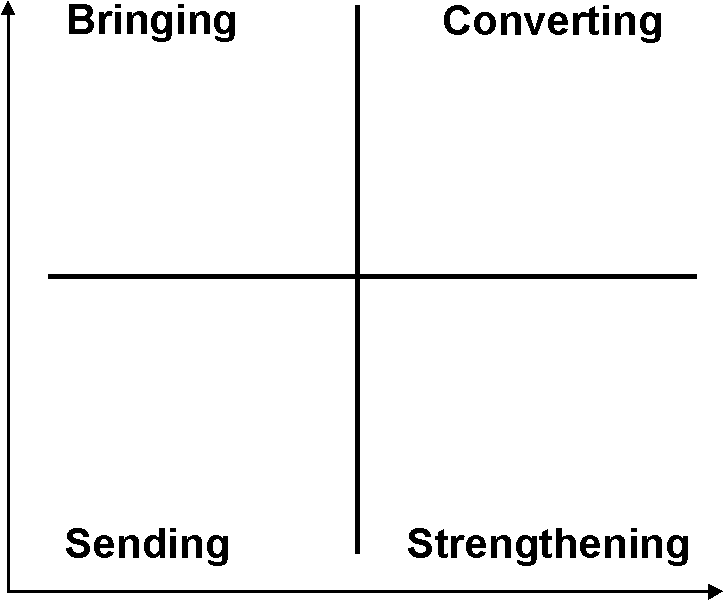
The following questions will help you complete this exercise:
1. What are you doing to bring unchurched youth into the group?
2. What context is provided in which youth hear the gospel and can be converted?
3. What strategy is used to strengthen believers in their faith?
4. What strategy do you have for sending them out to do ministry?
Footnote:
1Relational Youthwork, edited by Pete Ward, Lynx Communications, Oxford, 1995. This page is a brief summary of chapter 7. It is a highly recommended book for youthworkers and includes chapters on Christian relational care; evangelism among pre-Christian young people and programming; and relationships in youth ministry. The book is produced by the Frontier Youth Trust which is linked to the Oxford Youth Works.
Return to Model of Youth Ministry